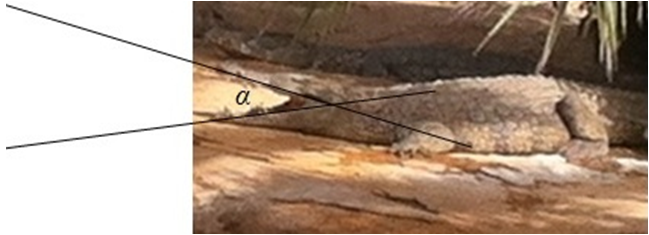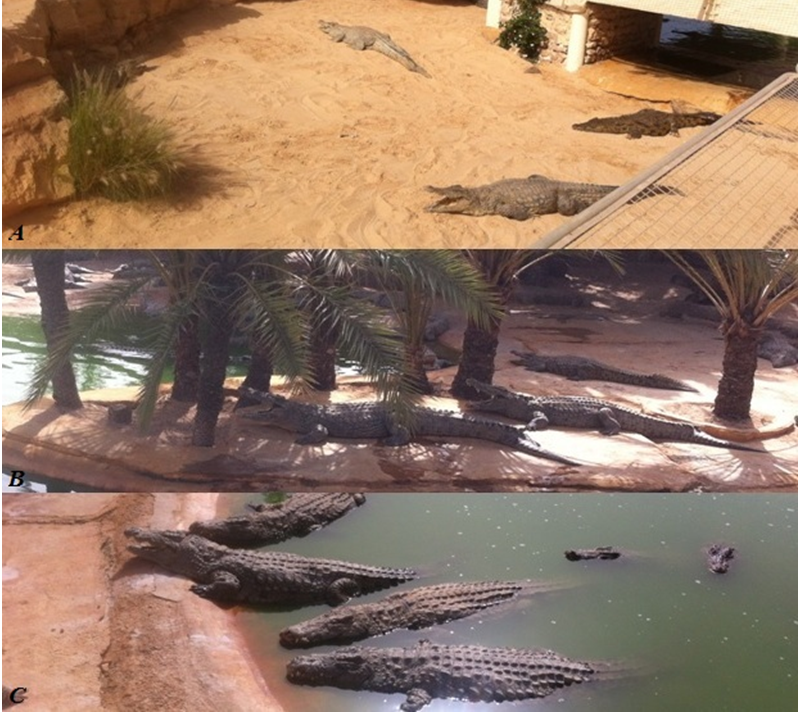УГОЛ РАСКРЫВАНИЯ ПАСТИ НИЛЬСКОГО КРОКОДИЛА CROCODYLUS NILOTICUS ПРИ БАСКИНГЕ
DOI: https://doi.org/10.23670/IRJ.2018.75.9.019
УГОЛ РАСКРЫВАНИЯ ПАСТИ НИЛЬСКОГО КРОКОДИЛА CROCODYLUS NILOTICUS ПРИ БАСКИНГЕ
Научная статья
Киладзе А.Б.*
ORCID: 0000-0001-9243-5922;
Институт проблем экологии и эволюции им. А.Н. Северцова РАН, Москва, Россия
* Корреспондирующий автор (andreykiladze[at]yandex.ru)
Аннотация
Рассмотрен один из аспектов поведенческой терморегуляции нильского крокодила Crocodylus niloticus Laurenti, 1768 (Crocodylidae, Crocodylia) в условиях крокодиловой фермы в Djerba Explore Park (о. Джерба, Тунис). Наблюдение за баскингом провели для 12 взрослых особей 3 июня 2018 г. в дневное время при температуре воздуха +29°С. Установлено, что ширина раскрывания пасти во время баскинга определяется углом между разомкнутыми челюстями, который в среднем составляет 26 ± 1°, варьируя в пределах 18−32°.
Ключевые слова: нильский крокодил Crocodylus niloticus, терморегуляция, угол между открытыми челюстями, градусная мера, баскинг.
ANGLE OF MOUTH GAPING OF THE NILE CROCODILE CROCODYLUS NILOTICUS AT BASKING
Research article
Kiladze A.B.*
ORCID: 0000-0001-9243-5922;
A.N. Severtsov Institute of Ecology and Evolution, Russian Academy of Sciences, Moscow, Russia
* Corresponding author (andreykiladze[at]yandex.ru)
Abstract
One of the aspects of the behavioral thermoregulation of the Nile crocodile Crocodylus niloticus Laurenti, 1768 (Crocodylidae, Crocodylia) under the conditions of a crocodile farm in Djerba Explore Park (Djerba Island, Tunisia) was considered. Observation of the basking was carried out for 12 adult individuals on June 3, 2018, in the daytime at an air temperature of + 29°C. It was established that the degree of mouth gaping during basking was determined by the angle between the open jaws, which on average was 26 ± 1°, varying from 18° to 32°.
Keywords: the Nile crocodile Crocodylus niloticus, thermoregulation, angle between the open jaws, degree measure, basking.
Introduction
The ability of crocodiles to thermoregulation, which increases and decreases the body temperature, is achieved due to specific acts of behavior, the most important of which is basking [3, P. 185−192], [9, P. 549−557], [10, P. 77−86]. It is considered that such type of behavior is related to the ability of the individuals to bask in the sun, move between land and water or to cover in the shadow [3, P. 185−192], [10, P. 77−86]. It is known that the Mugger crocodile Crocodylus palustris Lesson, 1831 during the temperature peak is even able to hide in burrows as a protective measure [3, P. 185−192], [8]. In this regard, the crocodiles thermoregulation is directly dependent on environmental conditions and behavioral adaptation [2], [3, P. 185−192].
One of the basking visually distinctive features is the open jaws, which increase the evaporative cooling [3, P. 185−192], [5, P. 443−467]. Open jaws should be considered as an element of a potentially useful mechanism related to the heat release [3, P. 185−192], [11, P. 235−236]. Thus, when the American alligator Alligator mississippiensis Daudin, 1802 opens the jaws during the basking, it reduces the heat increment in the head and gives the possibility to increase the body temperature to the required level [3, P. 185−192], [11, P. 235−236].
The basking features of the Nile crocodile Crocodylus niloticus Laurenti, 1768 were described in several studies earlier [1, P. 211−356], [3, P. 185−192], [4, P. 463−469], [5, P. 443−467], [6, P. 81−88]. It seems that the latitude of the inhabitation and air and water temperature influences the frequency and prevalence of basking [3, P. 185−192]. Seasonal aspects also affect the behavioral thermoregulation. Thus, in Zimbabwe, individuals of the Nile crocodile stayed in the state of basking more often in winter than in the summer period [4, P. 463−469]. Additionally, during the winter period the opening jaws can be also a signal of the Nile crocodile threatening behavior [4, P. 463−469].
Many issues of such an interesting behavioral aspect of the crocodiles’ life are still poorly studied. Thus, the gaping angle of the mouth is mentioned only in few studies [7, P. 25−38], however, it is obvious that such feature can also be of the species-specific nature, and depend on environmental factors.
In this regard, the aim of this paper is to describe the variants of basking and to determine the gaping angle of the Nile crocodile jaws.
Material and methods
Observation of specimens of the Nile crocodile Crocodylus niloticus Laurenti, 1768 (Crocodylidae, Crocodylia) was carried out on June 3, 2018, on a crocodile farm in Djerba Explore Park on Djerba Island (Tunisia), in the daytime from 3.44 pm to 4.01 pm. On that day, the weather conditions had the following parameters: air temperature was + 29°C; atmospheric pressure — 758 mm Hg; cloud cover — clear; wind — northeast; wind speed was 7 m/s (https://www.gismeteo.ru/diary/6517/2018/6/).
During the observation period, we saw and photographed 12 adult crocodiles with open jaws in the state of basking. The mouth gaping angle was determined from photographs. On the inner line of the opening of the jaws, we constructed two straight lines, at the intersection of which the angle α of jaw opening was found (Fig. 1).
Fig. 1 – Measurement of the angle (α) of the mouth gaping of the Nile crocodile Crocodylus niloticus at basking. Crocodile farm in Djerba Explore Park (Djerba Island, Tunisia)
Note: Photo by A.B. Kiladze
The angle α was measured by a protractor within the accuracy of 1°. The results were processed by descriptive statistics methods using STATISTICA 10 (StatSoft, USA). Statistical parameters were rounded to integer values.
Results and Discussion
According to our observations, crocodile can perform basking in the following cases: (i) lying in direct sunlight on the shore of the reservoir (Fig. 2A); (ii) were locating in the shade or half-shade under the trees (Fig. 2B); (iii) on partial immersion in water, usually by the back part of the body (Fig. 2C).
Fig. 2 – Variants of basking of the Nile crocodile Crocodylus niloticus with an open mouth: A − under direct sunlight on the shore; B − in the shade or half-shade under palms; C − with partial immersion in water. Crocodile farm in Djerba Explore Park (Djerba Island, Tunisia)
Note: Photos by A.B. Kiladze
During basking, the individuals remain immobile and can hold the mouth open for quite some time. Periodically crocodiles smoothly close and open jaws. The gaping angle of the mouth of crocodiles averages 26 ± 1° (Table 1).
Table 1 – The exponent of the gaping of the mouth of the Nile crocodile Crocodylus niloticus at basking (n* = 12)
| Statistical parameters | Angle of jaw opening (α, °) |
| M ± m | 26 ± 1 |
| lim | 18 — 32 |
| ± σ | 5 |
| Cv, % | 19 |
Note: n is the number of measurements; M ± m is the arithmetic mean with the error of the arithmetic mean; lim — parameter limits; ± σ is the standard deviation; Cv is the coefficient of variation.
It is obvious that during basking, crocodiles only slightly open their jaws, slightly opening the mouth, whereas when attacking a large prey they open it widely. Our results are close to the data obtained for the Mugger crocodile, as the angle between the open jaws during basking ranges from 20° to 25° [7, P. 32].
Conclusion
Scientific value of our results is as follows: (i) the data supplement information on the thermal biology of the Nile crocodile; (ii) the data are an example of the morphological and functional adaptation of the Nile crocodile to environmental conditions; (iii) the data complement the system of morphometric parameters of the jaw apparatus of the Nile crocodile at basking.
Thus, the usage of geometrical and statistical methods allowed us to clarify important features related to the physiology of the Nile crocodile.
| Благодарности Выражаю благодарность д.б.н. О.Ф. Черновой (Институт проблем экологии и эволюции им. А.Н. Северцова РАН) за редактирование рукописи | Acknowledgement I am grateful to Dr. O.F. Chernova (Severtsov Institute of Ecology and Evolution, Russian Academy of Sciences) for editing the manuscript. |
| Конфликт интересов Не указан. | Conflict of Interest None declared. |
Список литературы / References
- Cott H.B. Scientific results of an inquiry into the ecology and economic status of the Nile crocodile (Crocodilus niloticus) in Uganda and Northern Rhodesia / B. Cott // The Transactions of the Zoological Society of London. − 1961. − Vol. 29(4). − P. 211−356. https://doi.org/10.1111/j.1096-3642.1961.tb00220.x
- Cott H.B. Looking at Animals: A Zoologist in Africa / B. Cott. − New York: Scribner’s Sons, 1975.
- Downs C.T. Body temperature and basking behavior of Nile crocodiles (Crocodylus niloticus) during winter / C.T. Downs, C. Greaver, R. Taylor // Journal of Thermal Biology. − 2008. − Vol. 33. − P. 185−192. https://doi.org/10.1016/j.jtherbio.2008.02.001
- Kofron C.P. Behavior of Nile crocodiles in a seasonal river in Zimbabwe / C.P. Kofron // Copeia. – 1993. − Vol. 2. − P. 463–469.
- Loveridge J.P. Thermoregulation of the Nile crocodile Crocodylus niloticus / J.P. Loveridge // Symp. Zool. Soc. London. − 1984. − Vol. 52. − P. 443−467.
- Modha M.L. Basking behavior of the Nile crocodile on Central Island, Lake Rudolph / M.L. Modha // East Afr. Wildl. J. − 1968. − Vol. 6. − P. 81–88. https://doi.org/10.1111/j.1365-2028.1968.tb00904.x
- Rosamma K.M. Studies on Crocodilus of Kerala / K.M. Rosamma. − Unpublished PhD thesis. − Trivandrum: University of Kerala, 1993. − P. 25−38. – URL: http://hdl.handle.net/10603/140807 (accessed: 30.07.2018).
- Ross C.A. Crocodiles and Alligators. An Illustrated Encyclopedic Survey by International Experts / C.A. Ross, S. Garnett, T. Pyrzakowski. – London: Meerhust Press, 1989.
- Seebacher F. Patterns of body temperature in wild freshwater crocodiles, Crocodylus johnstoni: thermoregulation versus thermoconformity, seasonal acclimatization, and the effect of social interactions / F. Seebacher, G.C. Grigg // Copeia. − 1997. − Vol. 3. − P. 549–557.
- Seebacher F. Crocodiles as dinosaurs: behavioural thermoregulation in very large ectotherms leads to high and stable body temperatures / F. Seebacher, G.C. Grigg, A. Beard // J. Exp. Biol. − 1999. – Vol. 202. – P. 77–86.
- Spotilia J.R. Mouth gaping as an effective thermoregulatory device in alligators / J.R. Spotilia, K.M. Terpin, P. Dobson // Nature. − 1977. – Vol. 265. − P. 235–236.


